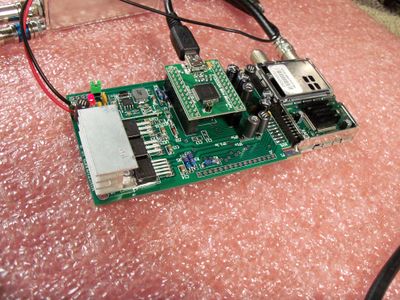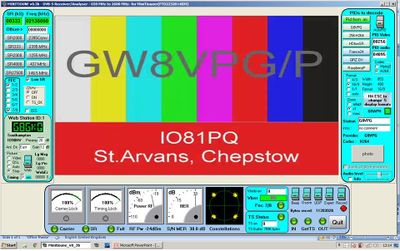Difference between revisions of "MiniTioune"
| Line 7: | Line 7: | ||
The simple hardware is designed for home construction and consists of 3 major components – the Tuner or NIM, the USB interface and power supply components. | The simple hardware is designed for home construction and consists of 3 major components – the Tuner or NIM, the USB interface and power supply components. | ||
| − | When used with the Sharp or Samsung tuner or NIM component, frequency coverage is from 650 MHz through to 2600 MHz. | + | When used with the Sharp or Samsung tuner or NIM component, frequency coverage is from 650 MHz through to 2600 MHz. (DVB-S and DVB-S2 QPSK and 8PSK) |
| + | When used with the Serit FTS4335 NIM component, frequency coverage is from 143.75 MHz through to 2450 MHz. (DVB-S and DVB-S2 QPSK, 8PSK, 16APSK and 32APSK) | ||
| + | This extended frequency coverage gives greater flexibility when working with up converters from the VHF bands and enables the 10 GHz band, including Es'HailSat-2 down link, to be received on a standard domestic PLL LNB. | ||
The tuner (NIM), pre-programmed USB interface module and a blank PCB are available from the BATC on line shop https://batc.org.uk/shop/hardware-and-kits – all other components are available from normal suppliers. | The tuner (NIM), pre-programmed USB interface module and a blank PCB are available from the BATC on line shop https://batc.org.uk/shop/hardware-and-kits – all other components are available from normal suppliers. | ||
Revision as of 07:20, 2 March 2017
MiniTioune (software)+ MiniTiouner (hardware) is a PC based system developed by Jean-Pierre F6DZP for receiving digital TV transmissions. It can be used to receive DVB-S QPSK and DVB-S2 QPSK, 8PSK, 16APSK, 32 APSK from broadcast and amateur TV transmissions with symbol rates (SR) from 30 Msymbols down to 120 Ksymbols per second enabling it to receive satellite broadcasts, "normal" ATV signals and Reduced Bandwidth (RB-TV) transmissions.
Hardware
The simple hardware is designed for home construction and consists of 3 major components – the Tuner or NIM, the USB interface and power supply components.
When used with the Sharp or Samsung tuner or NIM component, frequency coverage is from 650 MHz through to 2600 MHz. (DVB-S and DVB-S2 QPSK and 8PSK) When used with the Serit FTS4335 NIM component, frequency coverage is from 143.75 MHz through to 2450 MHz. (DVB-S and DVB-S2 QPSK, 8PSK, 16APSK and 32APSK) This extended frequency coverage gives greater flexibility when working with up converters from the VHF bands and enables the 10 GHz band, including Es'HailSat-2 down link, to be received on a standard domestic PLL LNB.
The tuner (NIM), pre-programmed USB interface module and a blank PCB are available from the BATC on line shop https://batc.org.uk/shop/hardware-and-kits – all other components are available from normal suppliers.
Full details on how the build the MiniTiouner including a "how to video" and a zip file containing circuit diagram, layout and build instructions can be found on the MiniTiouner hardware wiki page. Please note the “full kit” mentioned in documentation is no longer available.
Serit tuner
As of February 2017 the Sharp and Samsung tuners are no longer available and the project will use a NIM tuner from Serit FTS4335 which cover from 143.75 MHz right through to 2450 MHz without the need for any upconverters.
This makes building a receiver for 146 or 437 much easier, although you will need a pre-amp followed by lots of filtering for each band, just like the Sharp did, and probably followed by a Satellite line amp from ebay as the Serit has less gain than the Sharp.
However, due to a different pinouts from the Sharp NIM, the Serit FTS4335 NIM tuner will also need a simple adapter board to enable it to be plugged in to the MiniTiouner standard hardware - Brian G4EWJ has designed a board and they are currently being made in China.
The board and a full set of components plus the Serit FTS4335 NIM tuner are available from the BATC shop. Full details of this board and using the tuner are available here.
Band Pass filters
Receive upconverters
The new Serit NIM FTS4335 covers 143.75 - 2450 MHz and does not require any external frequency converters.
As mentioned above, the Sharp tuner component (also called NIM) used in a MiniTiouner only covers a maximum of 650 to 2600 MHz.
Whilst this is fine for the 23cms (1.3 GHz) and 13cms (2.3 GHz) amateur bands it does not provide coverage of 146 (2mts) and 437 MHz (70cms) where the majority of ATV operation takes place. Therefore we need to use an upconverter in front of the tuner which converts 146 MHz and 437 MHz up to an L band frequency that the MiniTiouner will receive.
A separate section on the wiki gives details of these upconverters.
Software
The system uses free to download DVB-S receive and analysis software called "Minitioune" written by F6DZP. The Software is hosted on the VivaDATV forum. You need a log-in to download, but here are the links:
The latest (11 January 2017) version of MiniTioune V0.6d: Minitioune v0.6d download
Noise Power Measurement Software: ( included in the Minitioune software package)
Software Installation
There is a "readme.pdf" in the Minitioune software package
For a step by step guide on how to do this, see the paper written by W6HHC - http://www.w6ze.org/DATV/InstallingMiniTiouner_onWin10.pdf
- Install the D2XX drivers 2.12.24 found at http://ftdichip.com/Drivers/D2XX.htm. There's a link in the right column for a setup executable. This stage is missing from W6HHC notes.
- Install the FT2232H USB driver for the MiniTiouner board
- Inspect the FT2232H USB-controller module (preprogramed by BATC for NIMtuner) for correct internal memory programming
- Install LAVfilters CODECs and test the HW board and test the DirectShow filters
- Look in the Minitiouner folder that you've just copied to C:\ for the small program "Install_usrc_ax_winXP" and run this to install the link with the decoder.
- Run the MiniTiouner_v0.6d executable & perhaps adjust the decoder filters being used.

